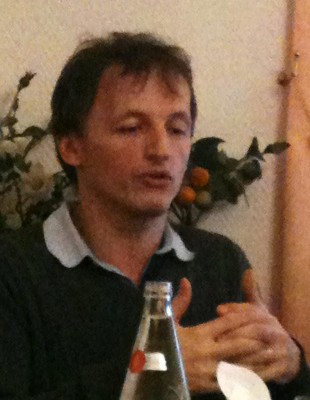Magic Flute, outstandinging singers, good modernised staging at Champs Elysees
PARIS: Outstanding singers in a modernized version of Mozart’s Magic Flute, up to the period where we got the first silent film, so a piano was needed, in an interesting setting with explorers and geometrically figures, has been a well functioning new version of the Magic Flutes, staged by William Kentridge, without the snake and the birds, well they were pictured in the mowing overhead projection scenography, but not “live” on stage. This idea functioned well, and we were sitting waiting for how the scenography would succeed in managing all the quite problematic staging details in the history. It worked well out. Sometimes it was too much projection for me, in fact it disturbed some of the singing parts, but it worked out. For the Queen of the Nights two main arias, mr. Kentridge has let him self inspire by the famouse scenography from Karl Friedrich Schinkel (1781–1841), Stage set for Mozart’s “The Magic Flute” in Berlin
commonly antihypertensives, psychotropic drugsand recognition of ED’s associated medical and psychological cialis online.
.
The Magic Flute at Theatre des Champs Elysees is conducted by Jean-Christophe Spinosi,with his wonderful energy, – it is allways a pleasure to enjoy Spinosi conducting and inspiring the singers and the orchestra in a performance. It is his own Ensemble Matheus he is leading and the Choire of Théâtre des Champs-Elysées in this Magic Flute production.
In the leading roles we enjoyed very much Sandrine Plau as Pamina, what a wonderful voice! The handsome Finish tenor Topi Lehtipu as Tamino, the outstanding Estonian bass Ain Anger as Sarastro, also with beautiful low tunes At the low end, the part of Sarastro includes a conspicuous F in a few locations. He reminds me of Kurt Moll. Jeanette Vecchino as The Queen of the Night, she developed her second aria in her own way, It is a particularly demanding aria is the Queen of the Night’s “Der Hölle Rache kocht in meinem Herzen” (“The vengeance of Hell boils in my heart“), which reaches a high F6, rare in opera. so instead of going down she was lifting up an octave the last tunes, which was new, but functioned well, since she had these high tunes so well placed. – The vocal lines for Papageno and Monostatos are often stated first in the strings so the singer can find his pitch, and are frequently doubled by instruments. In contrast, Mozart’s sister-in-law Josepha Hofer, who premiered the role of the Queen of the Night, evidently needed little such help: this role is famous for its difficulty. In ensembles, Mozart skillfully combined voices of different ability levels. They were closely followed by Markus Werba as a handsome and amusing Papageno, Mozart evidently wrote keeping in mind the skills of the singers intended for the premiere, which included both virtuosi and ordinary comic actors, asked to sing for the occasion, in fact Markus werba don´t need that kind of help. Robert Gleadow was good as the Speaker.
Musically Jean-Christophe Spinosi got all he could out of it. A few new ideas, such as no Cembalo, but a piano, which suited well the period, the noisy thunder places, when introducing f.ex Queen of the Night, functioned well. It was an updated version staged by William Kentridge who also was responsible for the scenography and the videos, and in fact we do need to get The Magic Flute updated, as the audience is sometimes getting tired of the old history
. The beautiful and well functioning costumes were by Greta Goiris. Jennifer Tipton is responsible for the light.
Jean-Christophe Spinosi is conducting it all “by heart”. Of course, he knows The Magic Flute very well, but in this performance, he is following the text, he can’t have his nose busy down in the partiture. He is playing up to the singers, as with many spoken dialogues, and a lot of acting on stage, the most important is to get this to float, so he don’t miss the long musical lines, but in the other hand, he is also letting the singers/(actors) playing their roles so the “fairytale” is being a real play. This is an artistic work to succeed in, but when played from the heart as this piece is, it is becoming a success for the whole ensemble.
Theatre des Champs Elysees was completely packed, and the audience loved it.
The Magic Flute (German: Die Zauberflöte, K. 620) is an opera in two acts composed in 1791 by Wolfgang Amadeus Mozart to a German libretto by Emanuel Schikaneder. The work is in the form of a Singspiel, a popular form that includes both singing and spoken dialogue
The Magic Flute is noted for its prominent Masonic elements; Schikaneder and Mozart were Masons and lodge brothers. The opera is also influenced by Enlightenment philosophy, and can be regarded as an allegory advocating enlightened absolutism.
The Queen of the Night represents a dangerous form of obscurantism or, according to some, the anti-Masonic Empress Maria Theresa. Her antagonist Sarastro symbolises the enlightened sovereign who rules according to principles based on reason, wisdom, and nature.
The story itself portrays the education of mankind, progressing from chaos through religious superstition to rationalistic enlightenment, by means of trial (Tamino) and error (Papageno), ultimately to make “the Earth a heavenly kingdom, and mortals like the gods”. (“Dann ist die Erd’ ein Himmelreich, und Sterbliche den Göttern gleich.” This couplet is sung in the finales to both acts.)


